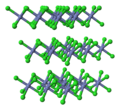Cobalt(II) chloride facts for kids
Cobalt(II) chloride is a chemical compound. It's also called cobaltous chloride or cobalt dichloride. Its chemical formula is CoCl2. This means it's made of one cobalt atom and two chlorine atoms. It's interesting because it can change color!
Contents
Cool Color Changes
Cobalt(II) chloride is usually seen as a red or pink solid. This happens when it has water molecules attached to it. If you heat this red form, the water leaves, and it turns into a blue solid. This blue form is called "anhydrous," meaning "without water."
The blue form is like a sponge for water! It can absorb water from the air and turn red again. This color change makes it useful for showing if something is wet or dry.
You can also make a different blue form by mixing cobalt(II) chloride with other chemicals that contain chloride (like hydrochloric acid or even table salt). When this mixture is heated, it becomes even more blue. This property helps scientists test for chloride ions.
How It's Made
The blue form of cobalt(II) chloride (without water) can be made by reacting cobalt metal directly with chlorine gas.
To make the red form (with water), you can react cobalt(II) oxide or cobalt(II) hydroxide with hydrochloric acid.
What It's Used For
Cobalt(II) chloride is a very common compound in science labs. It's often used to create other compounds that contain cobalt. Think of it as a starting material for making new cobalt-based chemicals.
Safety First
Like many chemicals, cobalt compounds can be harmful if you take in too much. It's important to handle them carefully and follow safety rules in a lab. They are not as dangerous as some other metals like lead or mercury, but they still need respect.
Related Pages
Images for kids





